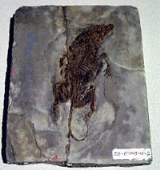
Zhangheotherium
Encyclopedia
Zhangheotherium is a genus
of symmetrodont, an extinct order
of mammal
s. Previously known from only the tall pointed crowned teeth, Zhangheotherium, described from Liaoning
Province, China
, fossil
s in 1997, is the first symmetrodont known from a complete skeleton. It was dated to between 145-125 million years ago in the Cretaceous
. A single species
, Zhangheotherium quinquecuspidens, is presently known.
Symmetrodonts and other archaic mammals such as multituberculates and monotreme
s are still being debated on their taxonomical relationships. Zhangheotherium has many primitive characteristics. Among them is a spur at the foot, seen today in the modern platypus
. In addition, it walked with a reptilian sprawl, not at all like our known mammals but instead like many Mesozoic
mammals, like Jeholodens
and Repenomamus
.
The specimen GMV
2124 of the feathered dinosaur Sinosauropteryx? sp.
contained 2 jaws of Zhangheotherium in its stomach region (Hurum et al. 2006). Thus, it seems to have preyed on this primitive mammal, possibly on a regular basis.
Genus
In biology, a genus is a low-level taxonomic rank used in the biological classification of living and fossil organisms, which is an example of definition by genus and differentia...
of symmetrodont, an extinct order
Order (biology)
In scientific classification used in biology, the order is# a taxonomic rank used in the classification of organisms. Other well-known ranks are life, domain, kingdom, phylum, class, family, genus, and species, with order fitting in between class and family...
of mammal
Mammal
Mammals are members of a class of air-breathing vertebrate animals characterised by the possession of endothermy, hair, three middle ear bones, and mammary glands functional in mothers with young...
s. Previously known from only the tall pointed crowned teeth, Zhangheotherium, described from Liaoning
Liaoning
' is a province of the People's Republic of China, located in the northeast of the country. Its one-character abbreviation is "辽" , a name taken from the Liao River that flows through the province. "Níng" means "peace"...
Province, China
China
Chinese civilization may refer to:* China for more general discussion of the country.* Chinese culture* Greater China, the transnational community of ethnic Chinese.* History of China* Sinosphere, the area historically affected by Chinese culture...
, fossil
Fossil
Fossils are the preserved remains or traces of animals , plants, and other organisms from the remote past...
s in 1997, is the first symmetrodont known from a complete skeleton. It was dated to between 145-125 million years ago in the Cretaceous
Cretaceous
The Cretaceous , derived from the Latin "creta" , usually abbreviated K for its German translation Kreide , is a geologic period and system from circa to million years ago. In the geologic timescale, the Cretaceous follows the Jurassic period and is followed by the Paleogene period of the...
. A single species
Species
In biology, a species is one of the basic units of biological classification and a taxonomic rank. A species is often defined as a group of organisms capable of interbreeding and producing fertile offspring. While in many cases this definition is adequate, more precise or differing measures are...
, Zhangheotherium quinquecuspidens, is presently known.
Symmetrodonts and other archaic mammals such as multituberculates and monotreme
Monotreme
Monotremes are mammals that lay eggs instead of giving birth to live young like marsupials and placental mammals...
s are still being debated on their taxonomical relationships. Zhangheotherium has many primitive characteristics. Among them is a spur at the foot, seen today in the modern platypus
Platypus
The platypus is a semi-aquatic mammal endemic to eastern Australia, including Tasmania. Together with the four species of echidna, it is one of the five extant species of monotremes, the only mammals that lay eggs instead of giving birth to live young...
. In addition, it walked with a reptilian sprawl, not at all like our known mammals but instead like many Mesozoic
Mesozoic
The Mesozoic era is an interval of geological time from about 250 million years ago to about 65 million years ago. It is often referred to as the age of reptiles because reptiles, namely dinosaurs, were the dominant terrestrial and marine vertebrates of the time...
mammals, like Jeholodens
Jeholodens
Jeholodens was a primitive mammal belonging to the Triconodonta family, and which lived in present-day China during the Middle Cretaceous about 125 million years ago....
and Repenomamus
Repenomamus
Repenomamus is the largest mammal known from the Cretaceous period of Manchuria, and it is the mammal for which there is the best evidence that it fed on dinosaurs. It is not possible to determine if Repenomamus actively hunted live dinosaurs or scavenged dead dinosaurs.-Paleobiology:Repenomamus...
.
The specimen GMV
Geological Museum of China
The Geological Museum of China , built in 1916, is a geological museum, boasting 200 thousand specimens.This museum is located in the Xisi area of Beijing and opened on October 1, 1959. It is the earliest geological scientific museum of China....
2124 of the feathered dinosaur Sinosauropteryx? sp.
Sinosauropteryx
Sinosauropteryx was the first genus of dinosaur outside of Avialae to be found with evidence of feathers. They were covered with "furry" coats of very simple filament-like feathers...
contained 2 jaws of Zhangheotherium in its stomach region (Hurum et al. 2006). Thus, it seems to have preyed on this primitive mammal, possibly on a regular basis.

